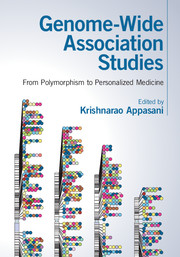Book contents
- Frontmatter
- Dedication
- Contents
- List of contributors
- Forewords
- Preface
- List of abbreviations
- Part I Genome-wide association studies
- Part II Genome-wide studies in disease biology
- Part III Single nucleotide polymorphisms, copy number variants, haplotypes and eQTLs
- Part IV Next-generation sequencing technology and pharmaco-genomics
- 15 Next-generation sequencing for rare diseases
- 16 Next-generation sequencing for complex disorders
- 17 Chromosomal breakpoints in breast cancer co-localize with differentially methylated regions
- 18 Signaling network analysis of genomic alterations predicts breast cancer drug targets
- 19 Pharmacogenetic studies in pediatric acute myeloid leukemia
- 20 Pharmaco-genomics of antiretroviral drugs
- Part V Population genetics and personalized medicine
- Index
- Plate section
- References
17 - Chromosomal breakpoints in breast cancer co-localize with differentially methylated regions
from Part IV - Next-generation sequencing technology and pharmaco-genomics
Published online by Cambridge University Press: 18 December 2015
- Frontmatter
- Dedication
- Contents
- List of contributors
- Forewords
- Preface
- List of abbreviations
- Part I Genome-wide association studies
- Part II Genome-wide studies in disease biology
- Part III Single nucleotide polymorphisms, copy number variants, haplotypes and eQTLs
- Part IV Next-generation sequencing technology and pharmaco-genomics
- 15 Next-generation sequencing for rare diseases
- 16 Next-generation sequencing for complex disorders
- 17 Chromosomal breakpoints in breast cancer co-localize with differentially methylated regions
- 18 Signaling network analysis of genomic alterations predicts breast cancer drug targets
- 19 Pharmacogenetic studies in pediatric acute myeloid leukemia
- 20 Pharmaco-genomics of antiretroviral drugs
- Part V Population genetics and personalized medicine
- Index
- Plate section
- References
Summary
Introduction
Breast cancer is the most common type of malignancy among women in many countries around the world. It is well established that multiple genetic and epigenetic factors play an important role in breast cancer. In the last decade, seminal work by Perou et al. (2000) and Sørlie et al. (2003) showed that breast cancer tumors consist of five gene expression-based molecular subtypes with different clinical outcomes. In addition, as cancers evolve, their genomes undergo massive alterations at the architectural level including rearrangements, deletions, and amplifications. Genome-wide high-resolution copy number profiling allowed characterizaiton of breast cancer tumors to be studied with unprecedented detail (Lucito et al., 2003). This type of genome instability in breast cancer has also been extensively characterized, first using array comparative genomic hybridization (CGH)-based methods such as in Hicks et al. (2006) Kamalakaran et al. (2009), Bergamaschi et al. (2006), Chin et al. (2006), and André et al. (2009), and more recently using high-resolution 500 k SNP arrays in, for example Haverty et al. (2008). These studies showed that cancer genomes are highly unstable, with recurrent, subtype-specific rearrangements, defining groups that are consistent with existing molecular subtypes (Weigman et al., 2012). Genome rearrangements occur frequently with copy number gains in 1q, 8q11, 11q, 17q, and 20q, and losses in 5q, 6q, and 8p. Very importantly, these regions harbor cancer-related genes such as TP53, CDKN2A, ERBB2, KRAS, and PTEN, and are therefore extensively cataloged. In Hicks et al. (2006), three patterns were defined to qualitatively classify genome rearrangement profiles of breast tumors and measure correlations with patient survival. One of these patterns is characterized by multiple closely spaced amplicons, called firestorms, affecting single chromosome arms which are correlated with poor survival. A formalization of the model was proposed in Russnes et al. (2010), using scores to quantify the complexity of genome-wide architectural distortion.
Epigenetic characterization of cancer using DNA methylation profiling of tumors and their corresponding normal profiles has shown that the methylation landscapes are quite disrupted in cancer. For example, the BRCA1 gene promoter is often hypermethylated in hereditary breast cancers (Tapia et al., 2008). Epigenetic profiling (Kamalakaran et al., 2010) showed that Luminal and non-Luminal breast cancer tumors have different methylation patterns and that differentially methylated genes are associated with relapse risk and overall survival.
- Type
- Chapter
- Information
- Genome-Wide Association StudiesFrom Polymorphism to Personalized Medicine, pp. 255 - 268Publisher: Cambridge University PressPrint publication year: 2016



